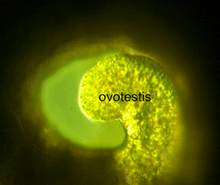Ovotestis
An ovotestis is a gonad with both testicular and ovarian aspects.[1][2] In humans, ovotestes are an anatomical abnormality associated with gonadal dysgenesis.[3] In invertebrates that are normally hermaphroditic, such as most gastropods (snails and slugs) in the clade Eupulmonata, an ovotestis is a common feature of the reproductive anatomy.
In mice, ovotestes are structured such that the central region is testicular tissue while the poles both contain ovarian tissue. Experiments involving the Sox9 gene, which is initiated by the SRY region of the Y chromosome, have shown the gene’s requirement for testicular differentiation from the presence of ovotestis formation within XX Sox9 trangenic mice. (6) Ovotestis within B6-XYPOS mice allow for gonadal development research within the same tissue to take place in ways previously unavailable.[4][5]
In gastropods

An ovotestis or hermaphroditic gland (Latin: glandula hermaphroditica),[6] is found as normal anatomical feature in the reproductive system of some gastropods including such species as the land snail Helix aspersa.[7]
See also
References
- ↑ "eMedicine - Ovotestis : Article by Gail F Whitman-Elia, MD". Retrieved 2008-01-02.
- ↑ "ovo-testes (formerly called "true hermaphroditism")". Intersex Society of North America. Retrieved 2007-12-08.
- ↑ Salas-Cortés L, Jaubert F, Nihoul-Feketé C, Brauner R, Rosemblatt M, Fellous M (2000). "SRY protein is expressed in ovotestis and streak gonads from human sex-reversal". Cytogenet. Cell Genet. 91 (1–4): 212–6. doi:10.1159/000056847. PMID 11173859.
- ↑ Gregoire EP et al. (2011). “Transient development of ovotestes in XX Sox9 transgenic mice.” Dev Biol. 394(1):65-77
- ↑ Wilhelm D, Washburn LL, Truong V, Fellous M, Eicher EM, Koopman P. Antagonism of the testis- and ovary-determining pathways during ovotestis development in mice. Mechanisms of Development. 2009;126(5-6):324-336.
- ↑ (in Hungarian) Páll-Gergely B. (2008). "A Stylommatophora csigák ivarszervrendszerének magyar nyelvű nevezéktana". Malacological Newsletter 26: 37-42. PDF.
- ↑ Chase R, Antkowiak T, Geoffroy E, Weatherill D (2004). "Why the ovotestis of Helix aspersa is innervated". Acta Biol. Hung. 55 (1–4): 239–49. doi:10.1556/ABiol.55.2004.1-4.29. PMID 15270240.